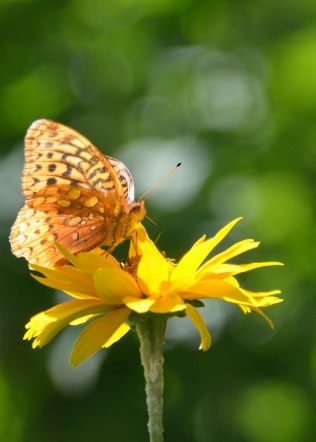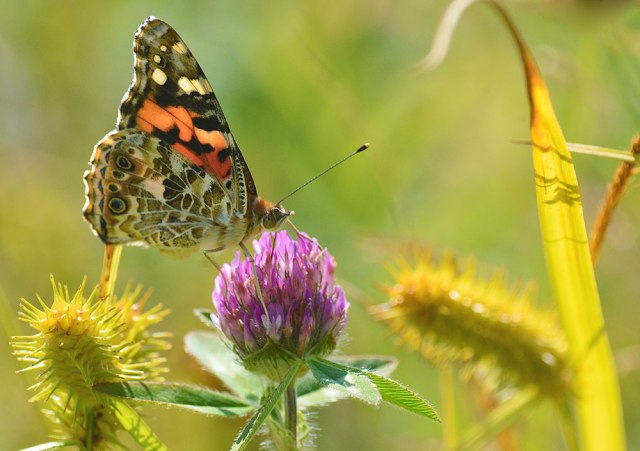I wish I could make this post humorous and not at all technical, but unfortunately the title already tells you it might just be about the backgrounds in photos. Your subject may be clear-cut, but that is not always the whole story in an image according to professionals.
They say the background is an important player in making a pleasing image, and I very much agree. Backgrounds are both an opportunity and a challenge. They not only put the subject in context, but they also can overwhelm a subject or distract from it.
What if the background supports a subject in such a way that it is hard to crop out all the extra elements? Many non-professionals (such as myself) will often leave in elements not necessary to the story the image is trying to tell. If you can’t reframe a flighty subject, is that always a bad thing?
I could have shot the first image above tighter like the next two, but by combining different elements can also place the focus ON the subject. Making the background a solid color helps it from being too busy. Too many elements will lead the eye out of the image or away from the subject. It is always a consideration but then again, what is the subject?
Do you like the whole image or the cropped one? More flowers showing is kinda interesting too.
Where Color Makes the Difference
Above, I think the hint of extra flowers was just as interesting as the fly on one. The soft color is very important to this image.
Rules, Rules, Rules. Typical rules and options include:
- Be aware of your background.
- Simplify the background, by moving position, reframing or blurring it.
- Filling the frame and eliminating much of the background.
- Cropping the background to remove distractions.
- Frame both the subject and its background.
- Create your own background, like a whiteboard, making it go black or blowing it out with light.
- Post process the background.
I know I have a tendency to thumb my nose up at the rules on occasion. I also know it may not be good photography in doing so, but something tells my artistic side to just go with it and let it happen.
Which Do You Pick?
Every image in this post has the better, more carefully framed subject in another shot of the same subject. The sun glare washes out the subject below, but also adds something to the image. I find this busy image interesting in all its complexity.
Competing lines below (distracting or adding interest?).

Shallow subject to background distance allows in a lot of the background plants. Distracting, or interesting?
Mottled or blurred light can make an interesting background. Using a wide aperture to blur the background was used below.
Busy scene below, yet pleasing colors in the next two images.
Which one is more interesting?
Are All Colors Good Together?
Competing color, orange and pink? I like the softness to this photo, almost like the Red Admiral landed in a bowl of popcorn. Competing color is usually not recommended. For some reason, this does not bother me, perhaps the gray background tones down the orange.
Do you follow the rules of photo composition? Or do you think as long as you like it is A-OK?
Next post is on isolating the subject. The tip is one many forget.















I do a blend between my artistic eye and photo composition. Sometimes I make multiple copies of one photo and just play around with it. Sometimes I like to blur the background and bring into focus the forefront of the photo. Great Post – Happy Day 🙂
I wish I had the time on the blog to play with my images. I used to on GWGT to make some really nice art, but in the last few years I have been having less and less time. I have always liked the blur from my macro lens far better than one created in Photoshop though. My next post has those type of images, where the macro lens really does its job right. I think only the flies in this post used the macro lenses (105mm and 60mm).
Great advice, Donna. Your photos however have a natural knack, they have an ‘effortless’* beauty.
*the kind that derives from a natural talent! 🙂
Thank you Marina. I appreciate you so much.
For me, all my photos have a purpose. For example, how would I crop the photo of the butterfly with the stems that might be distracting? That would depend on how I needed to use it. Do I need a photo of a butterfly? I’d crop it very tightly, showing just a piece of the flower. A photo of a butterfly on a flower? The petals would be showing. Or a photo of a butterfly in a garden? Leave it the way it is. Sometimes I take photos and use them months later. It’s nice to have a selection of shots to choose from so that I might have one that works.(When it comes to insects, I’m lucky if I have one that’s not blurry!) Regarding rules: Some people are naturals when it comes to art, but even then, the rules can guide you and point out things you might not have discerned on your own. I think it’s helpful when you list these guides for us.
You have mentioned before on blurry images of birds and insects. I know what your problem is on both counts most likely. The lens you are using needs a fast shutter speed for wildlife photos. You need an increase of ISO. With insects, my bet is you are trying to get closer than the lens can handle. I don’t remember it’s distance away, but it is likely more than 18″. Many with long lens come in too close. One, the lens cannot focus that close and two, the closer you get the harder it is to hold the camera steady enough. Even macro lens which are made to get 6″ away, need to be very still not to get the blur. With a zoom, you have the luxury of getting back where a faster shutter speed is used (more light enters the scene). Use the flash on insects. Then there will be no blur. I have used it on perching birds too. It may not quite reach the bird, but I have seen it help a bit.
Thanks, I’ll try those tips. I’ve got some birds flocking around my feeder that I can practice on.
I agree with some of the comments here, that it depends on what the subject/focus is and also using a combination of composition and artistic view point. What’s visually appealing to one person may not be appealing to the next.
My point exactly. Like photographers say, it is about the story one is telling. I think more story is had usually when more information is in an image. Too often a macro says little more than. “I am big and I am beautiful.” Context gets lost. Yesterday Nat geo posted an image of two finches and ask readers what they were. What they did not tell readers was where the image originated. One finch was not found many places, yet the two looked very similar to each other. It was supposed to be a trick question. Sitting at a feeder, the reader had no idea each were different finches. The image served their intent, but did not offer readers a chance at identification. As for liking an image, it mostly is subjective. But there are images posted that I think 99% of viewers would like. Some are that good.
Great tips (and photos). The rules are good guidelines, a place to start.
True on the rules. I just don’t always consider them as hard and fast rules. I like seeing differently sometimes.
i once had a critique where it was mentioned the light spots showing through the leaves were distracting . I am more inclined to check for that now and change my position. But with birds, it is a matter of getting them in the frame quickly and I forget to check that out. Edges of the frame too have their challenge.. sometimes it is a matter of individual taste and I have been bowled over by the shots that broke the rules. I like close-ups as well as larger views that show the environment of the subject, telling more about their likes.i like how depth of field can draw your eye to certain subjects.
I also am aware of the white in any fashion in an image. It draws the eye right to the brightest spot in a photo. The only problem is of course avoiding them on a sunny or bright day. The contrast is too easily read by the camera. Repositioning is the only fix like in the first photo. Most will process them by burning them out with Photoshop, but you can see that would be a lot of intricate detailing in the one image since the white light spots are behind the subject. I was going to mention watching the corners and edges, but that is a “tip” for any image shot, especially those landscape shots where it is really easy to include in distractions and unnecessary elements. My next post looks at depth of field more and ways to achieve it. But most all that hold a camera know that, so I go in a bit of a different direction aiding it. As for local critiques, I talked about them on GWGT. I tire of them and don’t participate. The judges are not necessarily the best or most experienced photographers. They go strictly on rules and totally disregard the art of the discipline in most cases. Anybody can be technically correct, but being an artist actually takes talent, and I think they should reward those showing initiative to be a standout. I never once entered because as I mentioned, when all they care about is if an image is tack sharp, and not the difficulty level in its execution – like some wildlife photography – I am not very interested in what they have to say. I sign up for working with only top industry professionals. I plan on a few workshops that are not online, but at wonderful locations. One on one with these Nat Geo photographers is where one really learns things that are important. One class I just took said a few things that would shock these “rules” judges. It would really humble them. I may post his words because they made more sense than any rule out there.
I like the Butterfly colors the most on that first shot when you can really see all the colors. I believe I have followed some of these rules, but because I am not a professional photographer, I take a ton of liberty!!!!
I do pay attention to the rules, but then my artistic eye takes over and I opt for what is pleasing to me….I agree many of your images that flaunt the rules are my favs.